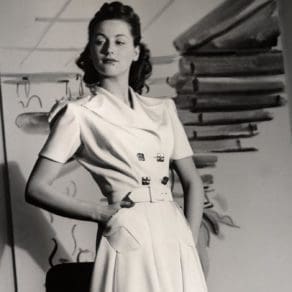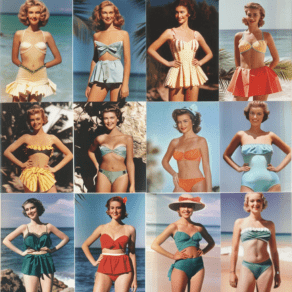1950s Women Fashion
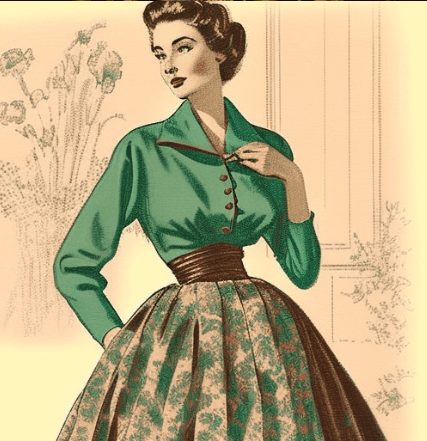
The 1950s were a pivotal decade in terms of women’s fashion. After the rationing of World War II ended, ladies were anxious to try on and wear the new fashions that mirrored the reviving spirit of the era. The ‘New Look,’ popular in the ’50s, was defined by a curvy, feminine form and an emphasis on high-quality fabrics and finishing touches.

Dorian Leigh

Dorian Leigh, one of the most famous models of the ’50s, was admired for her stunning good looks and versatility. She graced the covers of Vogue and Harper’s Bazaar on a regular basis, and many of the most prominent fashion designers of the day looked to her for inspiration.
Dorian Leigh was born in San Antonio in 1917. To date, 2008 is the last year she was seen alive. Her resume includes stints at illustrious labels including Balenciaga, Dior, and Chanel. Her daughter, the model Suzy Parker, was the result of her marriage to photographer Park Bailey. The Balenciaga and Dior gowns she donned in the ’40s and ’50s are among the most recognizable pieces she wore.
1950s Fashion Designers
Famous fashion designers from the 1950s include Christian Dior, Coco Chanel, and Cristobal Balenciaga. Dior’s “New Look,” with its voluminous skirts, nipped-in waists, and emphasis on luxury fabrics like silk and satin, was especially influential. Chanel, meantime, became famous for her classic, feminine, and refined fashions. In contrast, Balenciaga’s designs tend toward the sculptural and architectural.

1950s Clothing Colors

Clothing colors of the 1950s were typically vivid and eye-catching, with a concentration on primary colors like red, blue, and yellow. Shades of black, white, and gray were also widely worn, along with pastels. In the 1950s, people wore clothes with all sorts of print patterns, from bold geometric forms to delicate florals and everything in between.

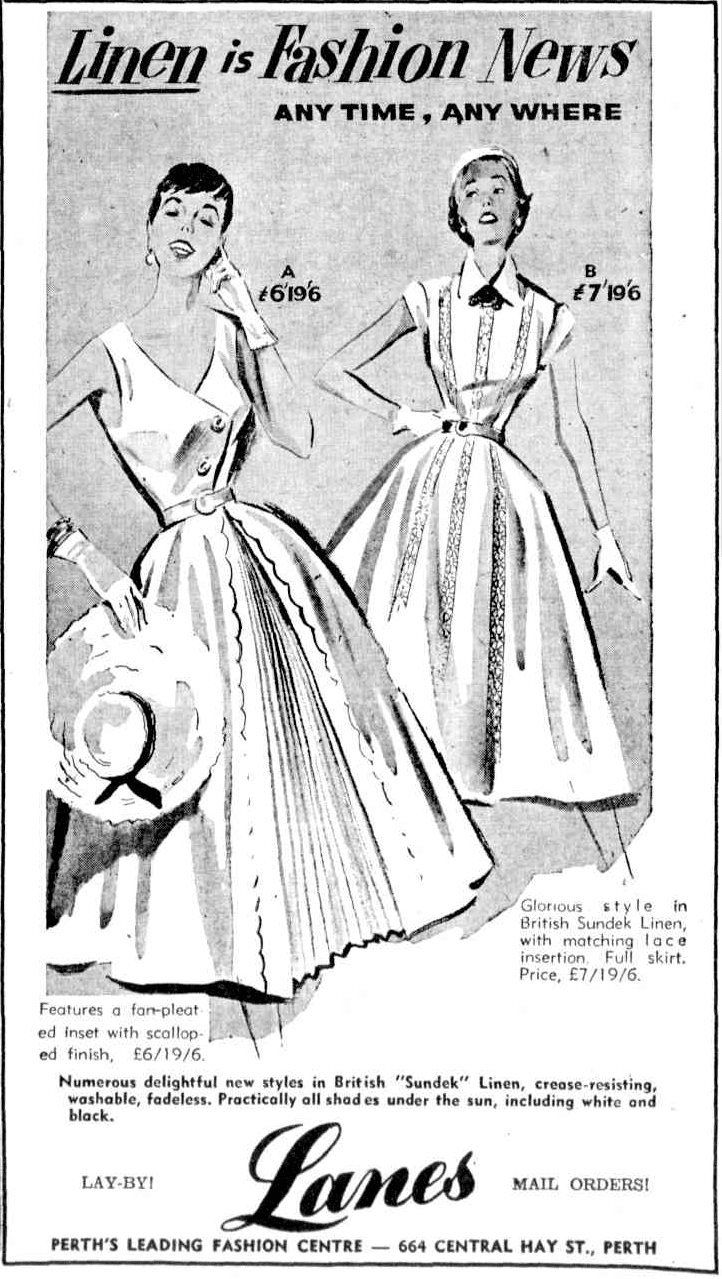
Traditional Values of Feminity
Women’s fashion in the 1950s was characterized by a return to traditional values of femininity alongside an emphasis on wealth and refinement. Dorian Leigh was one of the top models of the 1950s, and the decade produced many of the most recognizable and influential fashion looks of all time thanks to the efforts of designers like Christian Dior, Coco Chanel, and Cristobal Balenciaga.

Fashion reflecting the times: How culture, society, and politics shaped the fashion choices of the 1950s.
Fashion in the 1950s reflected the decade’s cultural optimism and economic growth. Bright colours, bold patterns, and playful details were all the rage because they represented the joy and hope that people felt.
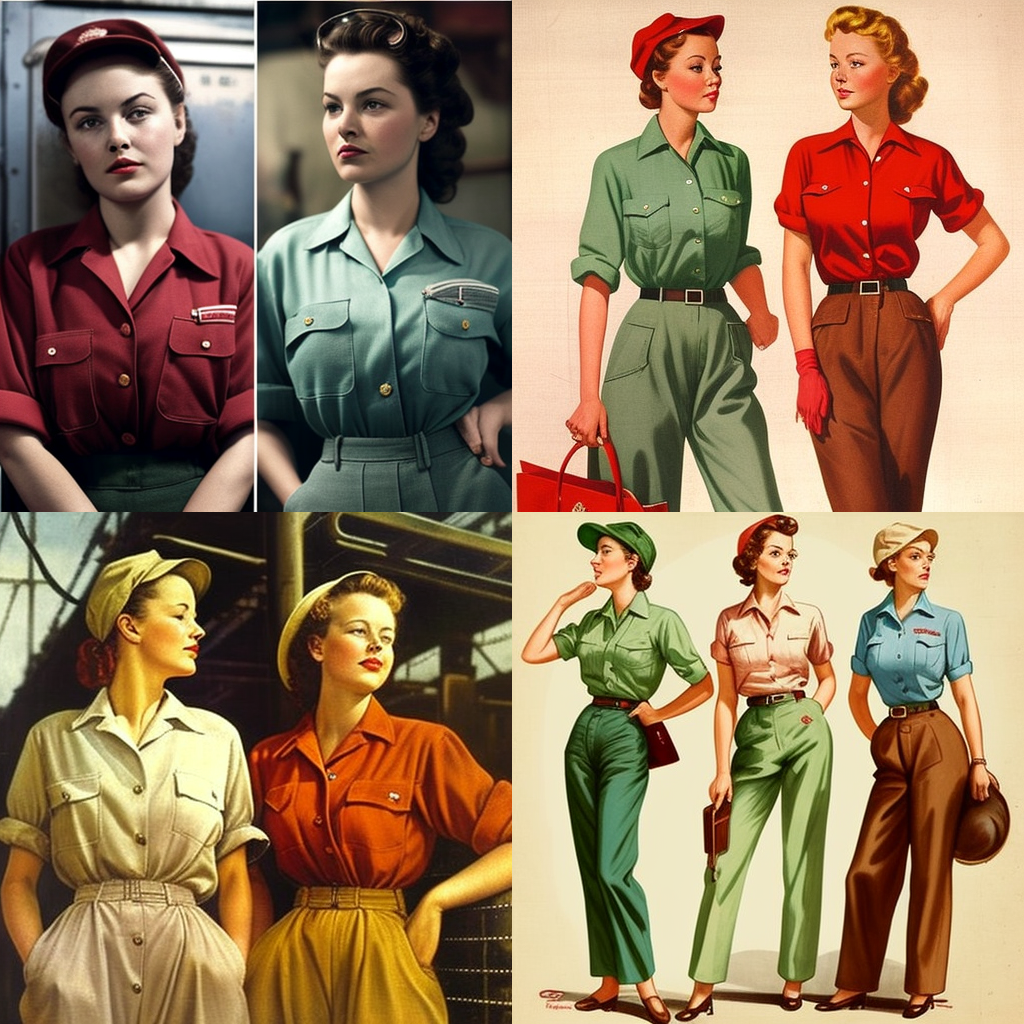
People were ready for a new start after the rationing and shortages of World War II, and this sentiment was reflected in the styles of the 1950s. Since many women were going back to the workforce, they needed workwear that was both appropriate and comfortable. The fashion of the 1950s was more laid-back than that of the 1940s because men were also seeking a more relaxed style at the time.

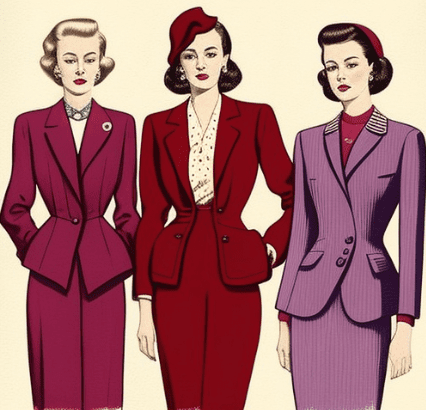
Politically, the 1950s fashion scene was heavily influenced by the Cold War and the fear of communism. Traditional gender roles and conservative clothing silhouettes were prominent in 1950s and 1960s American fashion as a reflection of the era’s conservative cultural climate. For this reason, many dresses were designed with full skirts and tight waists to emphasise the expected gender roles.
In conclusion, the fashions of the 1950s reflected the era’s prevailing social mores, political climate, and cultural mores. The changing social and political climate of the time, as well as the optimism and prosperity of the postwar period, were all reflected in the styles of the time.
Reviving the elegance of the past, shaping the fashion of the present: The 1950s influence on modern fashion.
Numerous aspects of today’s fashion can be traced back to the styles of the 1950s.
The 1950s introduced the hourglass silhouette, which is still widely worn today; it consists of a closely fitting bodice and a flared skirt. This silhouette has been reworked by many contemporary designers, who have included it in their collections while using contemporary fabrics and details.
Clean lines, precise cuts, and well-constructed garments were all hallmarks of the tailored clothing that experienced a renaissance in the 1950s. The importance of tailoring in contemporary clothing reflects this aesthetic.
Dressing femininely: The decade of the 1950s was a time when women were honoured for their grace and beauty, and this was reflected in the fashion of the day. This style is still very much in vogue, as evidenced by the prevalence of feminine details in many recent collections.
Many contemporary designers take cues from the styles of the 1950s and use retro details in their collections. The use of patterns, colours, and styles reminiscent of the past is one indicator of this trend.
The emerging popular culture of the 1950s, such as Hollywood films, television shows, and music, had a profound impact on the styles of the era. Popular culture has always had an impact on the fashion industry, and it still does today.

Iconic Styles: The “little black dress” by Coco Chanel, the full-skirt dress, the A-line dress, the shirtwaist dress, and the evening gown are all examples of timeless silhouettes that are still widely used and appreciated today.
Many elements from the 1950s that were influential on modern fashion are still referenced, updated, and incorporated into current styles.
Rebelling with style: The fashion of 1950s subcultures
Several 1950s subcultures, including those of African Americans, Latinxs, and the LGBTQ community, pushed the boundaries of what was considered attractive and fashionable.

The “Zoot Suit” subculture was an important one for African-American communities from the 1930s to the 1950s. Wide-legged pants, long jackets, and fedora hats were staples of the Zoot Suiters’ ostentatious wardrobe. African American youth used this fashion as a means of expressing their identity and pride in their culture while also serving as a form of protest against the prevailing trends of the day.
There were also Latino subcultures that pushed the envelope of what was considered attractive and fashionable. In the 1930s and 1940s, a subculture of Mexican Americans known as the “Pachucos” gained popularity for its members’ outlandish fashion sense, which included zoot suits, long hair, and a unique accent. For young Latinos, adopting this fashion was an act of defiance against the dominant culture in the United States.



Some LGBTQ (LGBTQ stands for lesbian, gay, bisexual, transgender, and queer or questioning.) subcultures that questioned conventional standards of attractiveness and style included drag queens and transgender people. High heels, wigs, and elaborate costumes were commonplace among a drag queen’s wardrobe staples. This trend was a way for members of the LGBTQ community to express themselves and question conventional notions of beauty and gender.

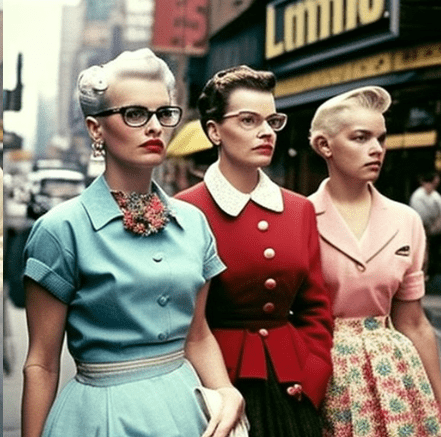

By expressing their distinct identities and cultures through their clothing, each of these subcultures in the 1950s contributed significantly to the evolution of popular beauty standards.
Beyond the housewife stereotype: Exploring the diversity of 1950s fashion
The 1950s were a time of great change for women in the workforce. As more and more women began to enter the workforce and break down traditional gender roles, their fashion and style began to evolve as well. During this time, working women were able to express their individuality and professionalism through their fashion choices, influencing the fashion and style of the era.
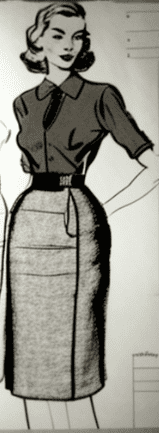
The pencil skirt became a symbol of the 1950s professional woman’s wardrobe. This form-fitting skirt was a common choice for women in the workplace; it was a signifier of both femininity and competence when paired with a blouse and cardigan. Women working as secretaries or in executive positions wore the pencil skirt.
The sheath dress was another common style for working women in the 1950s. This figure-hugging dress was a common choice for working women, especially when paired with the jacket of the same colour. When compared to men’s suits, sheath dresses were seen as a more refined and feminine option.
In the 1950s, women in uniform included nurses and flight attendants. Flight attendants wore fitted dresses in dark colours with matching jackets and pillbox hats, while nurses wore all white uniforms consisting of a dress, stockings, and shoes. These outfits were intended to project an air of authority and professionalism, and they were a visible sign of women’s growing participation in the workforce.


Working-class women, such as those in factories or farms, sported a more relaxed style. They typically sported pants, button-up shirts, and sturdy shoes for their daily activities. These garments were made to give women freedom of movement while still projecting an image of competence and power.
Women’s fashion and style changed throughout the 1950s as their roles in the workforce shifted. Women’s fashion choices influenced the style of the time because they allowed them to demonstrate their independence and competence in the workplace. Working women’s clothing in the 1950s not only mirrored the new roles that women were taking on in the workforce, but also helped to shape and challenge conventional notions of beauty and style.
However, it’s important to take into account the diversity of experiences, cultures, and backgrounds of working women during that time. Every woman had their own story and their own way of expressing themselves through fashion, which made the fashion of the 1950s even more interesting and diverse.
The power of style: How fashion broke barriers for working women in the 1950s
One way that fashion and style were used to convey independence and equality was through the use of more masculine clothing styles. Women who wore trousers, for example, were making a statement about their equality with men and their ability to do the same jobs as men. Similarly, women who wore blazers and other traditionally masculine clothing items were expressing their independence and desire to be taken seriously in the workforce.
Additionally, fashion and style were used to challenge traditional gender roles and societal expectations of women in the workplace. Women who wore form-fitting clothing, such as pencil skirts and sheath dresses, were challenging traditional ideas of femininity and proving that they could be both professional and feminine at the same time.
Unveiling the Charm of 1950s Fashion: Answers to Your Top Questions
What were the fashion trends in the 1950s?
Fashion trends in the 1950s included full skirts, tailored suits, and elegant dresses with cinched waists.
What was 1950s fashion like?
1950s fashion was characterized by a blend of elegance and conservatism, with an emphasis on feminine silhouettes and refined styles.
What was the fashion like in the 1950s?
Fashion in the 1950s featured a mix of classic designs and modern innovations, reflecting the post-war optimism and prosperity.
What was the fashion in the 1950s?
The fashion in the 1950s was defined by a return to glamour and sophistication, with women’s clothing highlighting hourglass figures and men’s fashion focusing on tailored suits and neat hairstyles.
What was fashion like in the 1950s?
Fashion in the 1950s was characterized by a departure from wartime austerity, with a resurgence of luxury fabrics, vibrant colors, and elaborate designs.
What was fashion in the 1950s?
Fashion in the 1950s was influenced by Hollywood glamour, European couture, and the rise of youth culture, resulting in a diverse range of styles and trends.
Who were the famous fashion designers in the 1950s?
Famous fashion designers in the 1950s included Christian Dior, Coco Chanel, and Hubert de Givenchy, who revolutionized women’s fashion with their innovative designs.
Where to buy 1950s fashion?
Vintage boutiques, online retailers, and specialty shops often carry 1950s-inspired clothing, offering a wide selection of dresses, suits, and accessories.
What is 1950s fashion?
1950s fashion refers to the clothing and styles popularized during the post-war era, characterized by elegance, femininity, and a focus on traditional gender roles.
What was the fashion trend in the 1950s?
The fashion trend in the 1950s was the “New Look” introduced by Christian Dior, featuring full skirts, nipped waists, and emphasized femininity.
What did fashion look like in the 1950s?
Fashion in the 1950s featured tailored suits for men, often paired with fedora hats, and full-skirted dresses with petticoats for women, epitomizing the ideal of the nuclear family.
What was women’s fashion in the 1950s?
Women’s fashion in the 1950s was characterized by full skirts, fitted blouses, and kitten heels, reflecting a return to traditional femininity and domesticity.
What influenced fashion in the 1950s?
Fashion in the 1950s was influenced by Hollywood stars like Audrey Hepburn and Marilyn Monroe, as well as European designers and cultural shifts such as the suburbanization of America.
How did Marilyn Monroe influence fashion in the 1950s?
Marilyn Monroe influenced fashion in the 1950s with her iconic style, often showcasing form-fitting dresses, bold prints, and glamorous accessories that epitomized the era’s feminine ideal.
How did the 1950s change the fashion industry?
The 1950s changed the fashion industry by introducing new silhouettes, fabrics, and production techniques that reflected post-war optimism and economic prosperity.
Celebrities who influenced fashion during the 1950s?
Celebrities who influenced fashion during the 1950s included Audrey Hepburn, Grace Kelly, and James Dean, whose iconic looks continue to inspire designers and fashion enthusiasts today.
What are the fashion for 1950s like?
Fashion for the 1950s featured a mix of classic elegance and youthful exuberance, with styles ranging from tailored suits to full-skirted dresses and casual sportswear.
Who influenced fashion in the 1950s?
Fashion in the 1950s was influenced by designers, celebrities, and cultural trends, with notable figures like Christian Dior and Audrey Hepburn shaping the era’s iconic styles.
What was men’s fashion in the 1950s?
Men’s fashion in the 1950s featured tailored suits, crisp white shirts, and narrow ties, reflecting a return to traditional masculine attire after the casual styles of the wartime years.
How did rock and roll influence fashion in the 1950s?
Rock and roll influenced fashion in the 1950s by inspiring rebellious attitudes and youth culture, with styles like leather jackets, denim jeans, and pompadour hairstyles becoming popular among teenagers.
What influenced 1950s fashion?
1950s fashion was influenced by a variety of factors, including post-war optimism, Hollywood glamour, European couture, and the rise of youth culture and consumerism.
What was the most popular fashion in the 1950s?
The most popular fashion in the 1950s was the full-skirted dress, often referred to as the “New Look” introduced by Christian Dior, which epitomized the era’s emphasis on femininity and elegance.
Lose Yourself in 1950s Fashion: Dive into the Era with These Iconic Movies
- “Grease” (1978) – This iconic musical follows the lives of high school students in the 1950s, featuring memorable fashion trends like leather jackets, poodle skirts, and saddle shoes.
- “Back to the Future” (1985) – While primarily set in the 1980s, the film’s time-travel plot takes characters back to the 1950s, offering a glimpse of classic 50s fashion such as letterman jackets and full skirts.
- “Rebel Without a Cause” (1955) – Starring James Dean, this film captures the rebellious spirit of 1950s youth culture and showcases iconic fashion pieces like denim jeans and leather jackets.
- “Roman Holiday” (1953) – Audrey Hepburn’s character explores Rome in elegant 1950s fashion, including chic dresses, tailored suits, and sophisticated accessories.
- “Some Like It Hot” (1959) – Set in the late 1920s but released in the 50s, this comedy features Marilyn Monroe in glamorous flapper-inspired attire, offering a glimpse of both eras’ fashion sensibilities.
- “Funny Face” (1957) – Audrey Hepburn stars in this musical romantic comedy, showcasing elegant Parisian fashion of the 1950s, including haute couture dresses and chic accessories.
- “A Streetcar Named Desire” (1951) – Set in New Orleans in the 1950s, this drama features characters wearing typical working-class attire of the era, including simple dresses and casual shirts.
- “Singin’ in the Rain” (1952) – This classic musical set in the 1920s offers a glimpse of Hollywood fashion of the 1950s, including glamorous evening gowns and tailored suits.
- “North by Northwest” (1959) – Alfred Hitchcock’s thriller features elegant 1950s fashion worn by leading lady Eva Marie Saint, including chic dresses and sophisticated eveningwear.
- “The Seven Year Itch” (1955) – Marilyn Monroe stars in this romantic comedy, showcasing her iconic blonde bombshell look with figure-hugging dresses and glamorous evening gowns.
We Hope You Like Our Selection: Feel Reborn in the 1950s with These Iconic Movies

